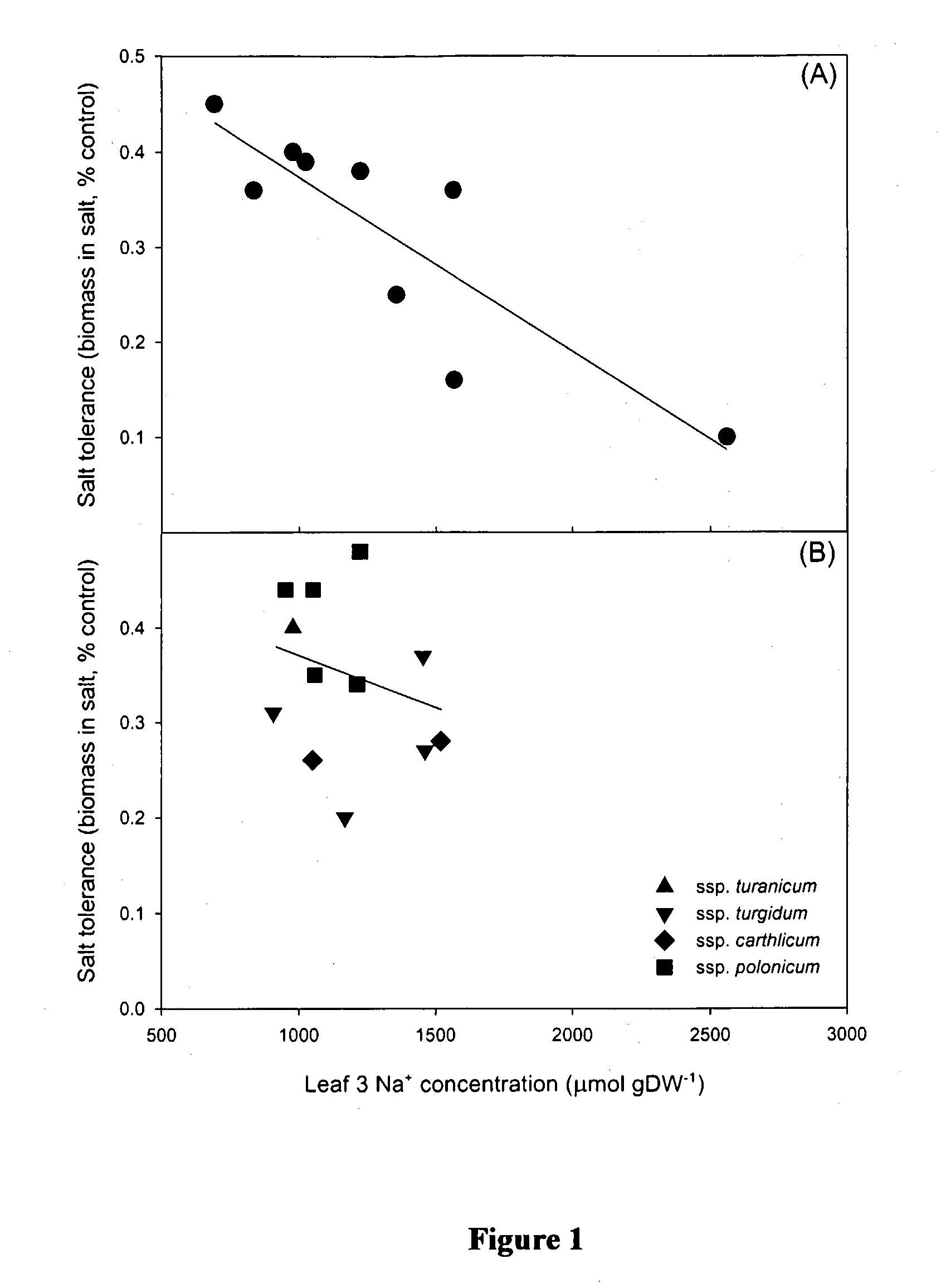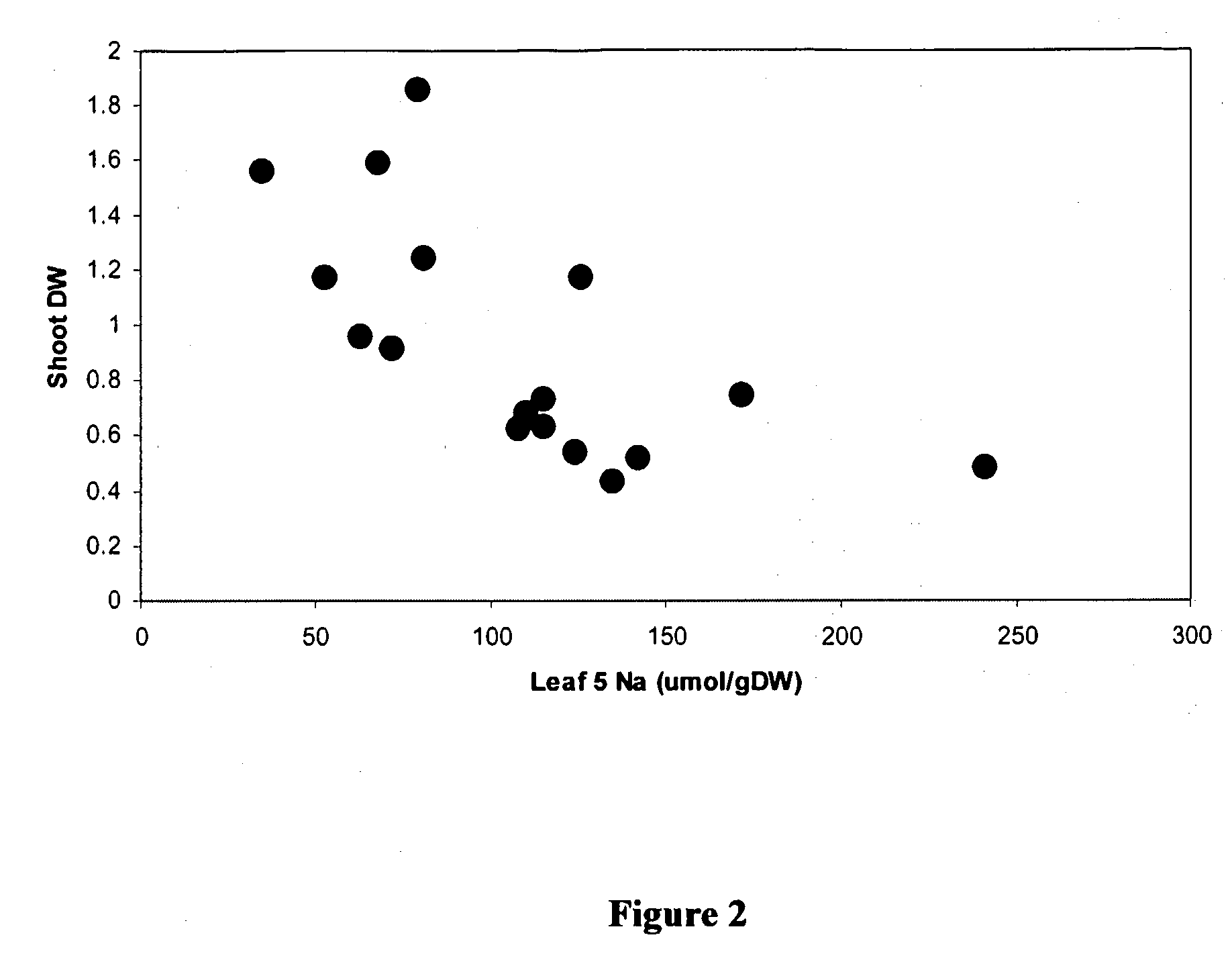Markers for Salinity Tolerance in Wheat Plants and the Use Thereof in Breeding Programs
a technology of wheat plants and nax loci, which is applied in the field of nax locus markers of wheat plants, can solve the problems of requiring labour and resources, unable to correlate with survival in the field, and difficult to screen large numbers of genotypes for salinity tolerance in the field, so as to achieve enhanced grain number and grain weight, and the yield of grain at 150 mm nacl was equally reduced.
- Summary
- Abstract
- Description
- Claims
- Application Information
AI Technical Summary
Benefits of technology
Problems solved by technology
Method used
Image
Examples
example 1
Assessment of Phenotypes of Wheat Varieties Grown Under Saline Conditions
Background
[0114] Screening large numbers of genotypes for salinity tolerance in the field is difficult, due to spatial heterogeneity of soil chemical and physical properties, and to seasonal fluctuations in rainfall. Screening techniques that can be carried out under controlled environments have therefore been used. Biomass production at high salinity (up to 250 mM NaCl) has been measured relative to biomass under non-saline conditions (for example, Kingsbury and Epstein, 1984; Martin et al., 1994). A screen by Sayed (1985) of 5,000 wheat lines, based on survival of high salinity, showed considerable genetic diversity amongst hexaploid and tetraploid lines. However, survival may not correlate with performance in the field. Leaf injury as measured by membrane damage (leakage of ions from leaf discs), premature loss of chlorophyll (using a hand-held meter), or damage to the photosynthetic apparatus (using chlo...
example 2
Mapping of Salinity Tolerance Locus on Chromosome 2AL of Triticum turgidum ssp. durum
Materials and Methods
Plant Material
[0133] A mapping population was derived from the cross between Line 149, a low-Na+ landrace of Triticum turgidum L. ssp. durum (Desf.) referred to in Munns et al. (2000) as selection number 126-775a, and the Australian durum wheat cultivar, Tamaroi, using 100 F2 phenotyped individuals. The F2:3 progeny were also phenotyped for sodium accumulation (n=15) and the data used to confirm the single-plant data for the F2 phenotype.
[0134] Two other populations were developed to verify the linkage of the marker to the Na+ exclusion trait, using crosses of Line 149 to two other high Na+ parents with unrelated genetic backgrounds: the cultivar Wollaroi, and the very high Na+ landrace Line 141 (Accession No. AUS12818). Populations of 100 F2 individuals were developed, and the F2:3 progeny means (n=15) were used to verify the phenotype of the F2 individuals.
[0135] Two ad...
example 3
Use of the Xpwm312 Marker to Identify Wheat Accessions with the Nax1 Locus
[0162] As described above, the wheat accession Line 149 had the Xgwm312 marker associated with the low sodium accumulation phenotype. Further wheat accessions including some durum plants were tested for the presence of the Nax1 locus using the PCR method described above with the Xgwm312 primers. Durum Line 150 (Australian Winter Cereals Collection, Tamworth, NSW, Australia—Accession No. AUS#17050), which showed an intermediate sodium accumulation phenotype in some phenotyping tests, and Line 151 (Australian Winter Cereals Collection, Tamworth, NSW, Australia—Accession No. AUS#17051) which was a low sodium accumulator, together with the three Triticum monococcum lines (C68-101 (Australian Winter Cereals Collection, Tamworth, NSW, Australia—Accession No. AUS# 90382), C68-124 (Australian Winter Cereals Collection, Tamworth, NSW, Australia—Accession No. AUS# 90393), C68-125 (Australian Winter Cereals Collection, ...
PUM
| Property | Measurement | Unit |
|---|---|---|
| Salinity | aaaaa | aaaaa |
Abstract
Description
Claims
Application Information
 Login to View More
Login to View More - R&D
- Intellectual Property
- Life Sciences
- Materials
- Tech Scout
- Unparalleled Data Quality
- Higher Quality Content
- 60% Fewer Hallucinations
Browse by: Latest US Patents, China's latest patents, Technical Efficacy Thesaurus, Application Domain, Technology Topic, Popular Technical Reports.
© 2025 PatSnap. All rights reserved.Legal|Privacy policy|Modern Slavery Act Transparency Statement|Sitemap|About US| Contact US: help@patsnap.com



